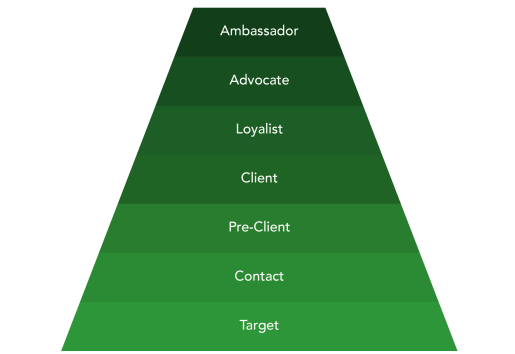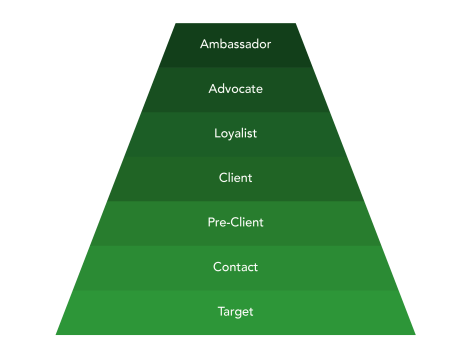The marketing pyramid – a tool for aligning marketing and sales and boost growth


Imagine that your marketing team and your sales team are perfectly aligned. Would that boost growth in your company?
Achieving alignment between marketing and sales is not impossible, but you need the right tools. One of them is the marketing pyramid.
A few stories
Some time ago, I asked one of my clients – a company from the insurance industry – to show me their sales plan. The marketing director showed me a table with sales objectives per month for each sales channel. The total amount of all channels was 30% of total revenue. I was surprised and asked her what was shown on the table. She said it was the estimated amount of new business. Then I asked her a few questions:
- How much is your churn rate? The answer was 30%. No growth!
- Do your salespeople participate in churn reduction campaigns? She said no, the sales director didn’t want them to lose focus on sales.
- Are your salespeople loyal to the company or do you have a high attrition rate? She said the attrition was high, the sales director struggled to retain good people.
- And do you get along with the sales director? “Well, let me put it this way, we are not close.”
At another client, a highly respected professional services firm, I asked one of the most prestigious partners to show me his sales plan. He said he didn’t need one, the clients were always asking him to perform more and more work, so he didn’t make any sales effort and he kept increasing his billing rate. An enviable situation, due to many years of hard work. Then I asked him a few questions:
- Is your team growing? He said no, the team was stable.
- Are you expanding the client base? He said no, quite the contrary, in fact he was keeping only the best clients.
- Do other partners in your firm refer you to their clients? He said no, never.
- And do you refer your clients to other partners? He answered occasionally, but always with the concern that their quality of service might not match his own.
- How old are you? He said 54 and mentioned that he would retire in a few years.
- And who is going to serve your clients after that? He didn’t answer, but I heard a giant click in his head.
Yet at another client, one of the market leaders in health care services, I asked the CEO about their sales plan. She answered that they didn’t have a sales plan, but she was happy to show me their revenue budget with a break down per health care ite. Then I asked her a few questions:
- How much do you spend to attract clients to your hospitals and clinics? She showed me their marketing communications budget, involving traditional media, social media and public relations. She also mentioned a content marketing team.
- Do your people promote your company? She said no, they were focused on providing high quality health care.
- Do you have a budget per service line? She answered no, because they didn’t know what the clients’ needs would be.
- Are your occupation rates high? She said no, and there were significant variations between service lines and health care sites.
- Are your clients happy? She handed me the latest client survey report, the satisfaction level was good, but it could improve.
- Do your clients refer your company to other people? She said they had no way of knowing.
- And do you have a loyalty program? No.
All these stories have two things in common, the companies don’t get the full benefit of their client base and they fail to plan sales.
In the first case, the insurance portfolio was off limits for sales, therefore salespeople didn’t care about churn and they didn’t participate in nurturing the client base. They didn’t develop long term relationships with their clients because it didn’t show on their numbers. In addition, salespeople felt they were expendable and didn’t feel connected to the company. The sales plan needed to include objectives for obtaining new business – in existing and new clients – and protecting current business. And salespeople needed to be rewarded for both.
In the second case, the highly successful partner was not aligned with the firm. He was not creating room for new partners in his team. His client base was almost of no use to anyone else in the firm and it would be lost after he retired. In addition, the firm was losing good clients only because he kept just the best ones. Instead of being overly focused on billable hours, he needed a sales plan to develop his team and expand the services of the firm in his client base. In addition, he could cease the opportunity to work with the marketing team to execute campaigns to attract new clients, leveraging on his reputation to boost the growth of the firm.
In the third case, the health care services group was not exploring its client base. No loyalty program was in place and the health professionals didn’t act as brand ambassadors. A sales plan was needed, including specific marketing campaigns aimed at maximizing the utilization of their resources in the different service lines at each health care site.
The marketing pyramid
Developing a good sales plan is not easy. It must include sales objectives per month, a marketing campaigns plan and an action plan per territory and channel. And it must be discussed and agreed upon between marketing and sales teams. At the core of this endeavor is the complete understanding of the client base and the non-client universe. The marketing pyramid is the tool needed to achieve that understanding.

The marketing pyramid represents the depth (or richness) of the relationship between the company and its clients (and prospective clients). It has different levels:
LEVEL | DESCRIPTION |
|---|---|
TARGET | The company doesn’t have the prospective client’s contact. It represents potential clients except self-excluded ones |
CONTACT | The company has the prospective client’s contact. It represents a website visitor, a target with a lost or abandoned sale, a churned client, or an ancient client |
PRE-CLIENT | The company has the prospective client’s contact and an open sales opportunity |
CLIENT | The client already bought something |
LOYALIST | There is a long relationship with the client, which is a frequent buyer |
ADVOCATE | The client recommends the company regularly |
AMBASSADOR | The client is an influencer |
The marketing pyramid is applicable for every kind of business, be it B2C, B2B, B2B2C or B2B2B. In fact, like B2C companies, the others can also have brand ambassadors, although most don’t even know it.
Clients may move up or down the marketing pyramid according to the depth of the relationship, but they never leave it.
The marketing pyramid captures the essence of all possible relationships of the company with its clients. It also has a visual advantage: the client must make some effort to move up on the pyramid, not everything is on the company’s back.
The marketing pyramid provides a complete view of the client base and the non-client universe. This is very important because marketing and sales share the same vision of reality, thus eliminating the reasons for misalignment.
The marketing pyramid is an excellent tool for defining sales objectives per territory, channel, offering and client segment because sales managers have the insight to set feasible sales goals without neglecting any potential business source. It is also an excellent tool for planning marketing campaigns because the marketing people have the insight to decide what campaigns are more appropriate in every business situation.
First sell campaigns are planned for non-clients or for new offerings to existing clients. Internet search campaigns are planned for clients and non-clients at different levels of the pyramid according to their familiarity with the company’s offering (not aware, aware, interested, in consideration). Next sell, cross sell, up sell and churn reduction campaigns are planned for existing clients. Remarketing campaigns are planned for website visitors. Product launch campaigns are planned involving brand ambassadors.
Sometimes product launches put stress on salespeople because on early stages of the product life cycle it is more difficult to sell and therefore to achieve sales goals. The marketing pyramid has the potential to eliminate this stress if marketing campaigns and sales goals are aligned.
In addition to planning, the marketing pyramid can also be used to detect product bundles or purchasing baskets, to detect cross sell, up sell and next sell opportunities and to perform data driven segmentation.
Depending on the type of business, the marketing pyramid can have different levels, for instance sublevels at each of the 7 levels pictured above, but its essence remains intact.
Ongoing alignment between marketing and sales
The marketing function has changed dramatically since the beginning of the current millennium. According to WARC, as we can see in the picture below, the internet represented more than 50% of worldwide advertising spend in 2020 and the trend is to increase.

Two important differences exist between internet and traditional advertising: immediate feedback and knowledge of the customer path. The latter means that the majority of leads generated by marketing campaigns can be traced back to the piece of advertising that originated them. This puts pressure over marketing teams, whose performance can be measured. The former means that marketing teams can change their advertising approach immediately. Because of this, the culture of marketing teams has been evolving to include some of the aspects of the culture of sales teams.
Analyzing the current relationship of the company with its clients became a regular activity, which reinforces the importance of the marketing pyramid.
Conclusion
The marketing pyramid is an innovative concept, based on years and years of research of best practices around the world in every type of business. By designing and implementing it, companies develop an important tool to gain competitive advantage over their competitors. Marketing and sales teams work together to define sales goals and plan marketing campaigns to achieve those goals. In addition, the marketing pyramid provides the base for a complete and objective understanding of the business.
Now you don’t have to long for the alignment between marketing and sales, you know how to foster it and boost growth at your company.
Filipe Simões de Almeida
Managing Partner, Fi Sales Consulting
Posted on 27-Mar-2021
